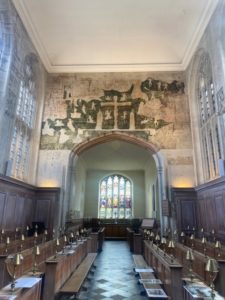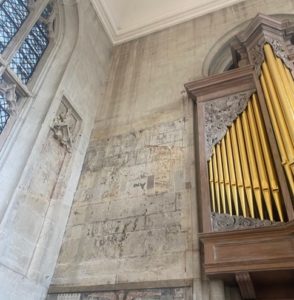
I’m Anna, a History of Art student, about to begin my second year in September. This summer, I was awarded a Collaborative Research Internship, ‘Investigating the Role of Women in the Guild Chapel, Stratford-upon-Avon.’ With the guidance of my project lead, Dr Elizabeth L’Estrange and help from the chapel’s wonderful volunteers, Janet Hall and Pamela Devine, I take great pride in the contribution I have made to their research and as the experience comes to a close, I can’t begin to describe how fortunate I feel for the opportunity.
The Guild Chapel dates back to the 13th century and is known for its wall paintings, which would have been used by guild members, to focus their worship and in doing so, gain security in the afterlife. However, during the mid-16th century, these paintings were covered over and only rediscovered in 1804. It has been my job to investigate these paintings, in terms of the women they depict in relation to their display, but also how they would have resonated to the users of the chapel. In doing this, I was really lucky that Janet shared the research that she has been doing on the different women in the chapel over the recent years.
Going into the project as a first year, I expected a challenge, but to future applicants, do not let this put you off! Given the 40-hour timeframe for the internship and feeling very new to academic research, I was worried that I would not be able to bring something new to the research already out there, but I was so wrong! I had the opportunity to visit the Guild Chapel and whilst there, I was shown antiquarian drawings by Thomas Fisher, which document what the paintings would have originally looked like. Volunteers and researchers have spent years trying to pinpoint the identities of the figures themselves, using these images. Conducting my research, I had to consider the years of information already out there, as well as all of the sources I had found. Given the timeframe, we realised that it would be difficult (without falling down rabbit holes) to try and identify each of the women. So, I decided to pull all the information I could find together, strip it back and create a simplified proposal for a learning and engagement tool, that chapel visitors could be provided with. I decided to create an audio guide (with a coinciding map) instead of a written document, to guide visitors around the chapel’s women, in a less ‘academic’, more conversational format. There are various representations of women around the chapel. I found that women had great value in the guild. You can find an abbess, a female leader, but also a weaver, a domesticated woman. All women of varying social ranking are placed on an equal playing field; they can all prepare for death and can be granted a place in the afterlife.

Going into the project, I was excited to partake on a journey that was both collaborative and independent. I feel this project has put me in great stead as I begin to think about my dissertation, as I start my second year. I’m so glad I threw myself into the project and didn’t feel put out as a first-year student. As a Catholic, I’ve always been interested in the art and iconography you can find in religious buildings. As a churchgoer since I was a child, I have always noticed a gender imbalance in the artwork inside churches. The art can be very male-oriented. I used to attend a church named after St. Theresa and even as a church dedicated to a woman, I feel she was not reflected sufficiently in the artwork. Her statue sits at the back of the church and the congregation turn their backs to her during mass. Therefore, I took great pride in my internship. Visiting a chapel that is so female-heavy in its painting scheme was extremely fulfilling and by creating an audio guide to the women, it felt like I was taking charge as both a Catholic and Art Historian! As well as being interested in religious art, I find the medieval period particularly interesting and as my internship progressed, I realised the project ties in so well thematically with my second year module about religious art in Northern Europe, which is actually being led by my project lead, Dr Elizabeth L’Estrange!
I have definitely thought different about research, both in terms of how to conduct it and in how to present it. I often used the Shakespeare Birthplace Trust’s digitised archives, which granted me easy access to resources from home. I also looked on-site at the chapel’s physical copy of the Guild Register. I have learnt that sources come in various formats and aim to expand my search for sources in future academic writing, by visiting different research libraries, as well as accessing online sources. It was also fun to think differently about how I’d talk about a topic I’m interested in, to an audience away from the History of Art students I’m used to presenting to!
I now have so much more of an insight into how careers in research can look and how significant heritage sites can be in the History of Art! I feel honoured to be able to put my work forward to the chapel and I aim to pilot my audio guide to students for feedback on a trip with my University in second year!
Anna Clarke, BA History of Art
